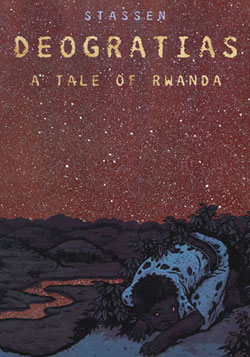Deogratias: A tale of Rwanda
By Hervé St.Louis
May 18, 2006 - 09:15
First Second Books,
Writer(s): Jean-Philippe Stassen
Penciller(s): Jean-Philippe Stassen
Inker(s): Jean-Philippe Stassen
Cover Artist(s): Jean-Philippe Stassen
ISBN: 1-59643-103-2
US $16.95 / Canada $22.95, 96 pages Full Color
 |
Translation: Alexis Siegel
Deogratias is a Hutu boy who loves Tutsi girls. In particular, he loves two sisters, Apollinaria and Benina. However their timing is off as the Rwandan genocide of 1994 is about to start. Ethnic tension between the communities is up, but Deogratias doesn’t give up, no matter what his fellow Hutus and their allies tell him. Who will make it out alive? This story won France’s Prix René Goscinny at the Angoulême show of 2000.
Stassen carefully introduces most factions of the Rwandan genocide and shows what happened before and just after. He also raises the old question of who will stand up to the propaganda and the rise of those who seek to hurt others in our society? Of particular interest is the attention Stassen gives to French individuals who collaborated with the Hutus and the fate of the small Twa, of Pigmy origin.
Stassen captures the society as it was during the just before the genocide, showing how racial slurs affected some Tutsis and how they dealt with it. He also shows the consequence of a country where a majority imposes its rule on a minority in the classrooms, the radio and the workplace. It’s interesting to note that he shows that European colonialism has not changed and that the Belgians were responsible for creating Ethnic groups in Rwanda while the French armed the Hutu perpetrators.
This story hurt when you see the savagery that was done and its effect on those with greater ideals like Deogratias. In the end nothing was gained by killing all the “cockroaches.” If you’ve ever read Hergé’s Tintin in Congo, it will show where the European started to cement their colonial impression on a similar neighbouring country while Deogratias will show you how these simple racial slurs could turn a people against itself decades later. The only missing faction in this story was the UN peacekeepers who tried to warn the world and stop the conflict from happening.
Stassen masterfully shows the facial differences in Hutus, Tutsis, and even the differences in Belgian and French characters. If you’re familiar with them, it’s easy to identify. Even if you’re not, after a while, one will start to notice that the French’s foreheads are larger than the Belgian’s square ones. As for the Tutsi, they are tall and thin. The Hutus, shorter and burlier. A good trick Stassen uses is to remove the panel borders from flashbacks. One problem, which is that the letterer did not put brackets around foreign languages. It would have helped a lot.
